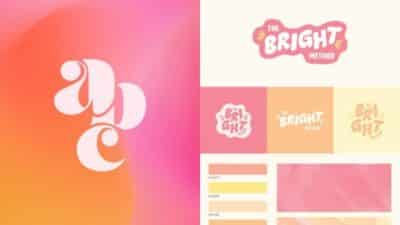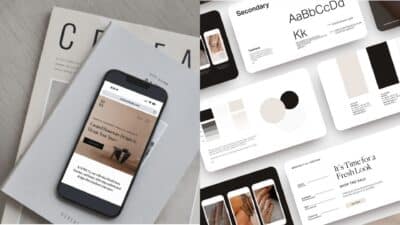
A logo is more than just a visual element; it’s the cornerstone of your brand identity. It’s the first impression you make and a powerful tool for brand recognition, leaving a lasting impression. Let’s delve into how a well-designed logo can elevate your brand.
What Is a Logo Meant to Do?
A logo is more than just aesthetics; it’s a powerful tool that goes beyond just looking pretty. It is the anchor of your brand identity. It should communicate your brand’s positioning, personality, and promise instantly. A good logo does so much more.
Core Function of a Logo
The core function of a logo is to serve as a visual representation of your brand. It’s to instantly convey what your business stands for, making it a vital component in your overall brand consistency. A unique logo helps in that effort, and services such as Printful or Printify allow brands to extend that consistency seamlessly from digital presence to physical products.
Communicating Brand Identity
A well-crafted logo is the essence of your business; it communicates your brand identity succinctly. The design elements should align with your brand message, ensuring that the logo reflects the true spirit of your brand.
Positioning and Personality
A strong logo is crucial for positioning your brand in the market and expressing its unique personality. It should evoke the desired emotions from your target audience, helping you differentiate your business from competitors.

The Psychology Behind Logos
The psychological impact of a logo is significant, influencing how potential customers perceive and remember your brand. A memorable logo builds trust, and that’s a powerful tool for brand building, specifically, brand recognition.
Influencing Perception and Trust
Logos influence customers’ perception, building trust through visual consistency and familiarity. An effective logo is key to fostering positive associations, impacting both perception and trust in your brand, not just for small businesses.
Color Associations
Colors in logo design evoke specific emotions and associations. A professional logo needs to consider these factors. Color choices, for instance, have specific connotations:
- Blue often represents trust and stability.
- Red signifies excitement and energy.
The right font is also a factor.
Shape Symbolism
Shapes are very important in logo design, contributing significantly to the psychological impact of the brand. For example, different shapes convey different feelings:
- Circles often represent unity and harmony.
- Squares can symbolize stability and strength.
- Triangles can convey energy and dynamism.
Different types of logos can utilize this.
Typography Choices
The typography in your logo must be carefully selected to reflect your brand’s personality. A modern sans-serif font can communicate simplicity and innovation, while a classic serif font conveys tradition and reliability, all adding to your brand consistency.


Case Studies: Logos That Changed Everything
Several iconic logos have significantly impacted their respective industries, serving as prime examples of how effective logo design can transform a successful business. Consider brands like McDonald’s, Nike and Apple for example.
Apple’s Logo Evolution
Apple’s logo evolution, from Newton’s complex image to the minimalist apple, reflects its shift towards simplicity and innovation. Each new logo phase reinforced Apple’s position as a leader in technology and design.
Nike’s Iconic Swoosh
The Nike swoosh is a prime example of effective logo design, symbolizing movement and speed. Its simplicity and memorability have made it one of the most recognizable iconic logos worldwide. Consider, also, Nike’s marketing strategy.
Airbnb’s Rebranding
Airbnb’s rebranding aimed to communicate a sense of belonging. Their new logo, the Bélo, represents people, places, and love, reflecting Airbnb’s mission to convey a global community experience.
How to Design a Powerful Logo

Creating a powerful logo starts with a strategic approach to logo design. A well-designed logo isn’t just about aesthetics; it’s about encapsulating your brand identity and effectively communicating your brand message to your target audience. This process requires clarity and precision.
Clarifying Brand Identity
Before you even begin to sketch, thoroughly understand your brand identity. What are your core values? What is your brand’s personality? What promise do you make to your potential customers? A strong logo should align with these elements, to convey it all.
Researching Audience and Competitors
Knowing your target audience is paramount. Research their preferences, values, and how they perceive your competitors. Analyze competitor logos to identify what works and what doesn’t. Use this to create a logo that stands out and evokes positive reactions.
Choosing Visual Direction
Select a visual direction that resonates with your brand and target audience. Consider colors, shapes, and typography that communicate the desired emotions and associations. Ensure that the design elements align with your brand consistency and brand recognition efforts.
Sketching and Testing
Begin sketching various logo concepts, exploring different shapes, fonts, and layouts. Test these sketches with a small group of your target audience to gather initial feedback. This iterative process helps refine your logo towards a more effective design, similar to the approach taken by the best UX companies. Note that a good logo goes through multiple iterations.
Validating with Feedback
Solicit feedback from stakeholders, potential customers, and design experts on your final logo candidates. Use this feedback to make final adjustments, ensuring that your well-designed logo resonates with your target audience and accurately reflects your brand identity. A memorable logo needs this validation.


Logo Design Tools and Platforms
In today’s digital age, there are many tools available that can help you create a logo. Choosing the right platform depends on your budget, design skills, and specific needs. Here’s a look at some popular logo tools and platforms to help small businesses.
Canva
Canva is a user-friendly design platform with a vast library of templates and design elements. It’s ideal for small businesses with limited design experience who need to create a logo quickly and affordably. It communicates easily with different integrations.
Adobe Illustrator
Adobe Illustrator is a professional vector graphics editor that provides unparalleled control and precision in logo design. It’s the go-to tool for professional designers and agencies needing to create a logo with intricate details and scalability. Its cost can be a factor for small businesses.
Looka
Looka is an AI-powered logo maker that generates logo options based on your brand preferences. It’s a fast and efficient way to explore a wide range of logo possibilities, making it suitable for startups looking for a quick brand identity solution.
Tailor Brands
Tailor Brands is another AI-driven platform that helps small businesses create a logo and build a complete brand identity. It offers various customization options and generates marketing materials, making it a comprehensive branding solution. It may not result in a unique logo.
ChatGPT Logo
ChatGPT Logo is a GPT-powered logo maker that helps you create a unique logo in seconds. Just describe your brand in a sentence, choose the designs you like, and let AI do the rest — no design experience required.

When to Hire a Professional Designer
While DIY tools offer convenience, certain situations warrant the expertise of a professional logo designer. Hiring a professional logo designer ensures that your logo accurately reflects your brand identity and resonates with your target audience. A well-crafted logo can make all the difference.
Signs You Need a Custom Logo
If you lack internal design skills, have a complex brand identity, or require a unique logo that stands out, it’s time to hire a professional logo designer. A good logo can significantly impact your brand recognition.
Importance of Brand Differentiation
In competitive markets, brand differentiation is crucial. A professional logo designer can help you create a logo that sets you apart from competitors and captures the attention of your potential customers, making your brand recognition better, so potential customers choose you.
High-Stakes Rebranding Needs
For high-stakes rebranding or product launches, a professional logo designer is essential. They can ensure that your new logo aligns with your strategic goals and communicates the desired message to your target audience. This ensures brand consistency.


Expert Tips for Logo Design Success
To achieve a successful business, having a well-designed logo is crucial. A logo should be more than just visually appealing; it should also align with your brand identity and communicate your brand message effectively to your target audience. These tips will help guide your logo process.
Keep It Simple
A strong logo should be clean and uncluttered. Avoid overly complex designs that can be difficult to remember. Simplicity enhances brand recognition, making your logo more versatile and easier to reproduce across various platforms. This ensures a memorable logo and brand consistency.
Test in Grayscale
Always test your logo in grayscale to ensure it remains effective without color. Color can enhance a logo, but the underlying design should stand on its own, to convey the correct message. This ensures that your powerful tool remains impactful.
Ensure Scalability
Your logo must scale well, maintaining its clarity and impact at various sizes, from a business card and product packaging to digital signage software displays and billboards. Ensure that the font remains legible and the design elements are recognizable, contributing to effective brand recognition and a strong logo.
Common Mistakes to Avoid
Creating a good logo requires avoiding common pitfalls that can undermine its effectiveness. A professional logo considers these mistakes, ensuring the logo remains timeless and versatile. Understanding these errors will help in the creation of a powerful logo.
Following Trends Instead of Strategy
Avoid designing a logo based solely on current trends, as they can quickly become outdated. Instead, focus on a timeless design that reflects your brand identity and aligns with your long-term business strategy. Otherwise, it might not communicate the right message to your target audience.
Overcrowding the Design
An overcrowded logo can be confusing and difficult to remember. Keep your logo simple, with a clear focus on essential elements. A memorable logo is often clean and concise, enhancing brand recognition and communicating effectively with the target audience.
Using Raster Files
Always use vector files (e.g., AI, SVG) for your logo, not raster files (e.g., JPEG, PNG). Vector files can be scaled without losing quality, ensuring your logo looks sharp across all applications and on the business card. This is a must for small businesses as well.
Neglecting Versatility Testing
Before finalizing your logo, test its versatility across various applications, including websites, social media, and print materials. Ensure it works well in different colors, sizes, and formats to maintain brand consistency. This guarantees brand consistency and improves brand recognition.
Conclusion: Your Logo is Your Brand’s Signature
A well-crafted logo is more than just an image; it’s your brand’s signature, conveying its essence and values at a glance. It influences customers’ perception of your business. The logo is often the first impression and the start of the lasting impression.
Emotional and Strategic Importance
The logo carries both emotional and strategic importance. It fosters emotional connections with your target audience and strategically positions your brand in the market, evoking a feeling of connection and trust. With a good logo, small businesses can grow.
Reevaluating Your Current Logo
Take a moment to reevaluate your current logo. Does it accurately reflect your brand identity and communicate your values effectively? If not, it may be time for a refresh or a complete redesign, especially, if the logo fails at brand recognition.
Next Steps to Take
To enhance your brand’s visual identity, you might consider a couple of options:
- Try a logo maker tool to explore new design options.
- Book a consultation with a professional logo designer for expert guidance to create a logo and improve brand recognition, so your successful business becomes even more successful.
- 0shares
- Facebook0
- Pinterest0
- Twitter0


